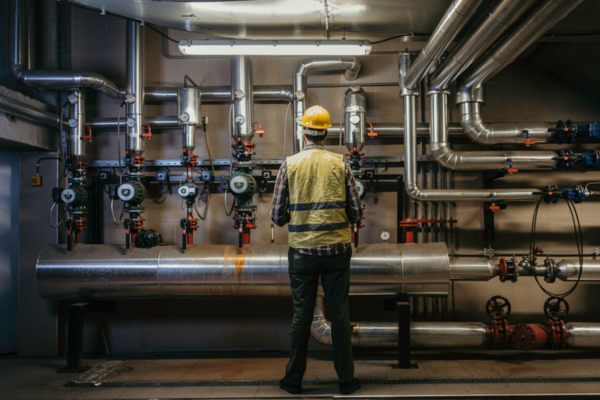Designing plumbing systems to minimise water hammer and noise
Taking the time to install a well-designed plumbing system has all sorts of paybacks, but no noise is one of the best for everyone involved. John Fennell explores.
With more complicated plumbing designs required to incorporate safety and energy saving equipment it is even more important to correctly design the plumbing system in order to eliminate the possibility of noise occurring throughout the system-either due to the flow of water or water hammer.
Water hammer is the pressure surge or shock wave caused when a fluid in motion is forced to stop or change direction suddenly. This commonly occurs with fast closing solenoid valves on washing machines and dishwashers.
Water hammer is a design issue and occurs in all pipe systems, but is often more noticeable in metallic pipes like copper or stainless steel due to their ability to transmit noise. The noise is a warning system that allows action to be taken before damage is done or the pipe bursts, but can often go unnoticed until obvious problems occur.
But it’s not only water hammer where noise can be an issue. High water velocities, damaged tap washers and poorly designed or installed plumbing can all create noise.
The Silent Treatment
As appliances become more technologically complex and safety regulations keep rising, plumbing systems need additional controls, including non-return valves, Pressure Reducing Valves (PRV’s) and Thermostatic Mixing Valves (TMV’s) that act to protect both the people using the system and the system itself. If the correct size pipes are used and the system is at the correct pressure then they should have no influence in the system.
There are complicated equations for calculating the effect of water hammer but the key parameters are pressure and water velocity through the pipes. If smaller pipes are used the water has to travel faster to obtain the same flow at the outlet.
One of the most common mistakes when installing plumbing is not using the material or size specified in the design. This may be due to a number of reasons like a lack of knowledge or availability of materials, but keeping costs down is often the most common. Most Hydraulic Consultants use design principles based around copper plumbing when calculating water usage, flow, velocities and pipe sizing.
If a design specifies DN20 copper pipe then this has an internal diameter of about 17mm. If the installer decides to use DN20 PEX pipe, it could have an internal diameter of about 14mm depending on the brand and type. What is more concerning is that the design of the fittings for many plastic pipes are significantly smaller and for DN20 PEX fittings it can be down to 11.2mm. The effect on the water velocity, compared to copper for the same flow, is that for the DN20 plastic pipe it would require a velocity 47% higher but the fittings requires an additional 130% (2.3 times) the velocity. (Note: AS/NZS 3500.1 and AS/NZS 3500.4 have equivalent pipe size tables and specify that DN20 copper is equivalent to DN25 PEX).
It is important for plumbers and installers that, if using a different pipe from that specified in the design, you need to check with the pipe supplier that the internal diameters of the pipes and fittings are equivalent or larger than the original design.
The other contributing factor for noise and water hammer is pipe supports. All pipes have a specified maximum spacing for brackets and clips as listed in AS/NZS 3500.1 and AS/NZS 3500.4. Copper and steel pipes require less clipping due to their rigid nature. Plastics require more clipping but many plumbers fail to correctly install plastics and these can float and bang on the walls when there is a pressure surge or water hammer.
Rising Issue
There’s been an increase in the number of noise issues being experienced within more complex piping systems in areas such as Health Care and Hospitality irrespective of the pipe material. Occasionally these are contained to warm water delivery lines from Thermostatic Mixing Valves (TMV’s) to fixture outlet, however at various sites noise is also occurring in some cold water lines or in areas where no TMV’s are installed.
TMV’s require the mandatory inclusion of a non-return valve as an integral part of the product to prevent cross connection of heated and cold water supply. Trials with different TMV’s, removal of the TMV’s, lowering the pressure and changing the end of line tapware generally did not eliminate the issue leading to the conclusion that it is primarily related to a combination of factors including pipe material choice, sizing and velocity issues.
One other issue has arisen being the possibility of Reverse Water Hammer. This is where a tap or control valve is located some distance away from the end of the pipe. As the tap or control valve closes, the flowing water causes a vacuum immediately after the device. The vacuum may suddenly reverse the water flow, causing a vibration and loud banging noise. To minimise this occurrence, the pipe work after the device should be larger thereby reducing the water velocity in the pipe on the outlet side.
Steps to minimise Noise and Water Hammer
– Design pipe work so that the velocity is no greater than 1.5 m/sec.
– Ensure that when changing materials or designs that the internal diameter of alternate material is the same, or larger, than the design criteria.
– Keep the pressure in the system well below 500 kPa with pressure limiting valves.
– Make sure that all pipe work is secured by clips at the correct spacing for the pipe material.
– Install one or more water hammer arrestors upstream of fast closing valves
– Install soft closing lever taps
– If taps or control valves are not at the end of the line, ensure that the outlet pipe is one size larger to eliminate reverse water hammer.
John Fennell. CEO, International Copper Association Australia.

